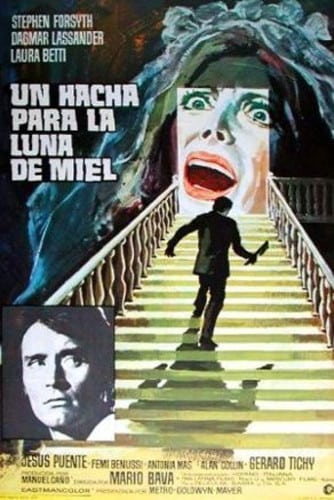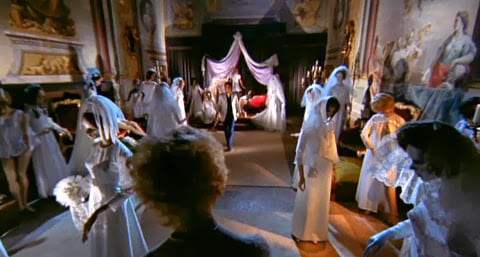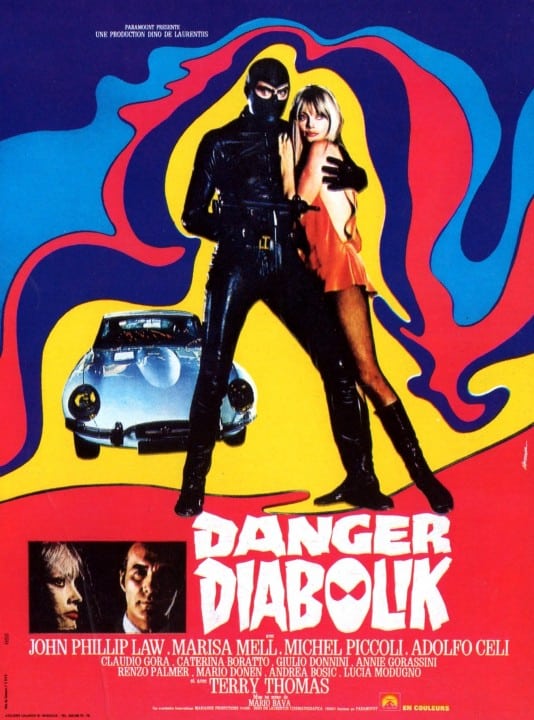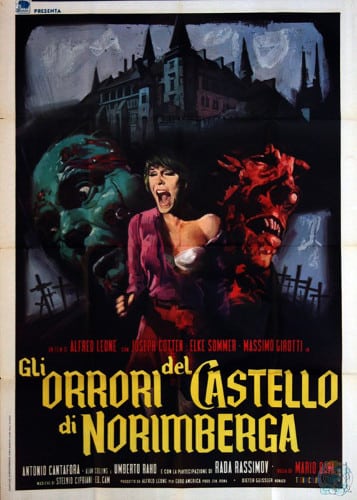Hatchet For The Honeymoon (1969)
Directed by: Mario Bava
Written by: Mario Bava, Santiago Moncada
Starring: Jesús Puente, Laura Betti, Stephen Forsyth
ITALY
AKA IL ROSSO SEGNO DELLA FOLLIA, THE RED SIGN OF MADNESS, BLOOD BRIDES
AVAILABLE ON BLU-RAY AND DVD [BLU-RAY REGION A ONLY]
RUNNING TIME: 90 min
REVIEWED BY: Dr Lenera, Official HCF Critic
Rather than have my usual brief synopsis of the first third of the film, I’ll let its anti-hero introduce this review. Over to you John:
My name is John Harrington. I’m 30 years old. I’m a paranoiac. Paranoiac. An enchanting word, so civilised, full of possibilities. The truth is, I am completely mad. The realisation which annoys me at first, but is now amusing to me. Quite amusing. Nobody suspects I am a madman. A dangerous murderer. Not Mildred, my wife. Nor the employees of my fashion center. Nor of course my customers….I have killed five young women. Three of whom are buried in the hothouse….There is one problem. I must go on wielding the cleaver. It’s most annoying. But when I begin to hear the footsteps. Those stealthy footsteps, I know I just kill. And shall have to keep on killing, until I find out the truth. That’s it, the whole truth….
Mario Bava’s very Freudian psycho thriller, which should probably have been called Meat Cleaver For The Honeymoon for its English language version as that’s what the murder weapon is, isn’t one of his better known pictures, and is somewhat awkward in places and let down by one major flaw which really hampers its effectiveness, but it’s still a highly interesting film which can partly be seen as Bava’s twist on Psycho, though it has many of the director’s interests, or rather obsessions, in full force and might be his most self-referencing movie, with many nods to Black And Black Lace in particular and even someone watching Black Sabbath on TV [and the bed which featured in such a scary part of that film turns up here too]. It was clearly a major influence on the film of American Psycho, and not just with its killer being a rich materialistic playboy who is attractive to women, but right down to copying certain scenes almost verbatim like when John tells a girl that he killed, raped and burned her sister, and she thinks it is a joke. Bava’s film, which was apparently viewed by the cast and crew of Mary Harron’s film prior to shooting, doesn’t flow anywhere near as well as her superb black comedy, but it’s an intriguing watch and thoroughly compelling nonetheless even if it only occasionally seems to shows the director in full flow.
The film began life as a screenplay by prolific Spanish scriptwriter by Santiago Moncada. Bava agreed to direct, but had to greatly alter the script when the actress Laura Betti expressed a desire to work with Bava, who then created the character of Mildred Harrington for her as well as turning what was a highly serious piece into something closer to a black comedy. Though the critics tended to not be too kind to Bava’s work, the man was held in high esteem by many of his peers, a good example of this being Betti who had just won the Volpi Cup for Best Actress for her performance in Pier Paolo Pasolini’s Teorema but wanted to move on to Bava. The majority of Hatchet For The Honeymoon was shot with a mostly Spanish crew at the former home of Spanish dictator Generalissimo Francisco Franco, with numerous policemen present during filming because there were concerns that fake blood might stain the floors and walls of the villa. As was often the case whether he was credited for it or not, Bava also photographed the film and also created the elaborate animated collage for opening credits from what largely looks like red and blue splodges of paint. The film was a moderate commercial success in Italy and elsewhere. In the US it was re-titled called Blood Brides, and the central character’s name altered from John Harrington to Oliver Barrington, the name John Harrington apparently considered too generic for the character.
The opening scene, which comes after some typical Bava light, sunny main title music [he didn’t seem to like his composers to suggest darkness immediately] is great, though a tad misleading at first, as the door of a cabin on a train opens and out comes John Harrington, who sees a boy down the end of a corridor. As he breaks into another cabin and slays an amorous couple with a cleaver, we are fed brief glimpses of something that happened in John’s past; steps, a cleaver, a man lying dead, a boy’s face, and other things too hard to make out because the imagery is too distorted. In time, these flashbacks will become clearer, but only because John has to repeatedly kill women, acts which he believes will explain both the flashbacks and why he kills, and not just women but pretty young women whom he has to dress up in bridal gowns in his house before he slashes them to death. This sounds extremely brutal, but actually Hatchet For The Honeymoon mostly cuts away before any violence, perhaps an odd choice from the director whose Black Sunday and Blood And Black Lace seemed to push the boundaries of screen violence at the time of their releases, though most of the film does seem to take place from the point of view of its main character who may not entirely notice the full horror of his acts anyway. We soon actually start to feel a bit sorry for this dangerous psychopath who is constantly belittled by his horrid wife and genuinely wants to find out why he is the way he is, even if ironically he has to carry on killing to do so. The script suggests that he may be impotent [not the first nor the last Bava character who has this condition], and his murdering of these women is a substitute for sexual intercourse, though even this guy’s wealth isn’t his own doing, his wife having made his fashion house business the big success that it is. He’s basically just one big façade.
John does seem to eventually fall in love, something not really explained in a satisfactory fashion except that Dagmar Lassander is a stunner, but of course has to try to stop his usual urges coming to the fore. By now, he’s not only being pestered by an inquisitive cop who acts uncannily like a precursor to Columbo [dare I say the producers of that show were influenced by this movie? – stranger things have happened], but is being haunted by the ghost of one of his victims, or should I say others are, because, in a neat twist on the usual situation, it’s others who see that someone is with him while he sees nobody, the only time we’re adopting a point of view other than John’s. Though the supernatural is alluded to in an early scene with Mildred attempts to contact her dead previous husband via a séance, the ghost stuff makes little sense, though it makes for some fine scenes of a darkly amusing manner if not much in the way of actual terror, Bava obviously feeling he had been there and done that. The final scenes aren’t as exciting as they could be, while the main climactic revelation comes as hardly a surprise, though another featuring a major character is a neat little twist and it all finishes in that great Bava ironic fashion.
There’s a sly sense of humour about the whole thing, something obvious early on when Bava cuts from a real train to a fake one and a human hand picking it up, and this is something which negates the tension a bit, though the director makes the most out of perverse moments when John caresses and kisses the numerous mannequins he has, scenes of a slightly necrophiliac tone which look forward to Lisa And The Devil, or when he constantly cuts to toys, which assume a sinister appearance during a conversation about childhood. Hatchet For The Honeymoon is rife with Bava themes like greed and sexual perversion, but it isn’t as overloaded with visual bravura as some of Bava’s other work – he actually tended to mute some of his stylistic tendencies in the latter stages of his career – but the flashbacks make startling use of ripples and kaleidoscopic patterns, while every now and again blue and/or red bathe parts of a scene, like when John is in a nightclub. Perhaps his greatest achievement in the film is putting us on John’s side, notably during a great moment of slightly comedic suspense when two cops come round to question John while the body of his latest victim is lying on the stairs about to drip blood – despite, and this is the big flaw with the movie I mentioned earlier – the thoroughly bland performance of Canadian actor Stephen Forsythe. The role of John Harrington is a complex one, and Forsythe just fails in any way to do it justice. This means that the film’s centre isn’t as strong as it should be.
Most of the other performances are fine despite much of the expected dubbing [as usual, those who can speak English generally are but suffer from being post-dubbed by others except for Forsythe], and Sante Maria Romitelli’s often ironically romantic score has a couple of catchy themes and some genuinely unnerving use of what sound like distorted trumpet notes at some moments. Overall Hatchet For The Honeymoon carries the sense that Bava wasn’t entirely sure what do with his material, but it’s still a bravely twisted piece that both shows the director trying to do some different things while, sometimes subtly, sometimes obviously, deliberately recalling some of his own stuff, and at times the work of other directors [it actually feels more Hitchcockian than The Girl Who Knew Too Much to me], meaning that, along with the fact that it seems like one of his most personal works, it’s possibly a more interesting picture to study than some of Bava’s more perfect ones.
Rating: 

















Be the first to comment